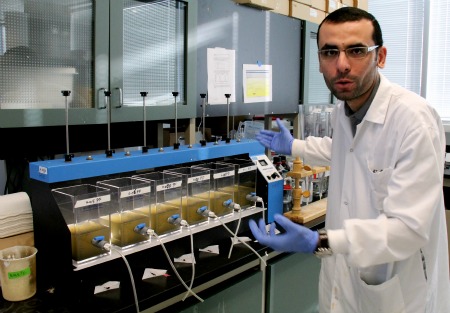
Vanier Scholarship recipient Haitham Elnakar sets up an experiment in which he will treat wastewater collected from the city's combined storm and sewage lines with Ferrate. The substance helps solids stick together and settle, and provides some disinfection. Working with EPCOR, Edmonton's waste water utility, and under the supervision of NSRC Industrial Research Chair Mohammed Galam El-Din, Elnakar is hoping to see this treatment method move to a larger scale.
(Edmonton) An environmental engineering PhD student is working with the city's waste water utility to develop a novel method of treating waste water that flows from combined storm and sewer pipes before it reaches the North Saskatchewan River.
The city ended the practice of building the combined sewers in the 1960s, but there are still 17 outlets from which a mix of raw sewage and storm water spill into the river, untreated, during heavy rainfalls. The city's waste water utility, EPCOR, is working on ways to capture and treat that water before it enters the environment. Most of the combined waste water is now diverted to the Gold Bar Wastewater Treatment Facility. During heavy rainfalls, EPCOR treats this waste water so that contaminants coagulate, form solids, and settle to the bottom of a primary settling tank. The water is then released into river.
"We have one level of treatment just for those wet weather events," explains Simon Thomas, EPCOR's director of waste water treatment in Edmonton. "The idea behind this research partnership is to enhance the settling and provide some disinfection."
"The ideal outcome is to reduce the microbial contaminants going into the river," says Abdul Mohammed, a senior wastewater treatment specialist with EPCOR.
Sewage alone is bad enough-human waste is hazardous and contains traces of drugs like antibiotics expelled from our bodies. But in a combined sewer, you'll also find so-called "emerging contaminants" washed down our storm and sewer drains every day. These emerging contaminants include nano-sized residues from a wide variety of materials. Products such as paint used on the exterior of buildings, and health and beauty products like cosmetics and sun screen can contain nano particles-and there are concerns that these non-regulated contaminants may have a major impact on aquatic environments.
Haitham Elnakar, a PhD student in the Department of Civil and Environmental Engineering, is hoping his research will help the city improve the way this combined waste water is treated to neutralize pollutants, separate emerging contaminants, and disinfect the waste-taking it to a level that exceeds environmental regulations.
Funded by NSERC, AITF and EPCOR, Elnakar's research project involves using ferrate, a highly charged iron molecule known as iron(VI), to provide effective primary treatment of this water. Elnakar says the waste water treated with ferrate will surpass legislated requirements.
"What is interesting is that industrial partners (EPCOR) came to us to help them address regulated contaminants-and we added non-regulated contaminants. They're now funding us to provide an engineering solution that also provides disinfection," said Elnakar, who earned his undergraduate's degree at Cairo University and master's degree at the American University in Cairo; both in Egypt.
Since arriving at the U of A, he has won a prestigious NSERC Vanier Graduate Student Scholarship, the U of A President's Doctoral Prize of Distinction, and the Alberta Innovates-Technology Futures Graduate Scholarship Top Up Award.
Elnakar explains that ferrate works in two ways. It's an oxidant, disinfecting E. coli and acting on contaminants of emerging concern. Because it has an unstable electrical charge, ferrate decomposes to yield hydrous iron oxide, a widely used coagulant. This coagulant draws particles into solids, called flocs, which then settle at the bottom of the tank.
Working under the supervision of Mohamed Gamal El-Din, a civil engineering professor who holds the NSERC Industrial Research Chair in Oil Sands Tailings Water Treatment, Elnakar is testing the effectiveness of ferrate against the use of peracetic acid, a potent antimicrobial organic compound, along with widely used coagulants, as part of his research project.
Ferrate is a "green" product that has no toxic byproducts but has not been used to treat wastewater on a large scale. Elnakar's research will determine how to best apply ferrate to combined wastewater.
Working in state-of-the-art research labs at the U of A helps Elnakar provide advanced engineering solutions. At present, he's mixing ferrate into runoff collected from the city's combined sewers. He analyses the samples to understand what pollutants are in the water, then treats them with varying amounts of ferrate. Ferrate's effect on the waste water is almost immediately evident during these experiments: the sewage begins to change colour as agitators mix the ferrate into it. In minutes, flocs form and connect with one another.
Next, Elnakar analyses the water floating on top of the settled solids-and he closely analyses the sludge to fully understand the impact of the ferrate treatment.
"We're testing different dosages of ferrate to determine the optimal treatment," he said, adding that he hopes to expand the experiments at the Gold Bar facility's pilot-scale model, to simulate how effective the treatment could be under actual variable quantity and quality inflow conditions.
Ultimately, the idea is to put the treatment to use in the enhanced primary tanks at the treatment plant that can handle 600 million litres of water per day.
The research could have a profound impact on the environment, and Gamal El-Din says that is due in no small part to the strong relationship between the U of A and EPCOR. Both Thomas and Mohammed are U of A engineering alumni. Over the years, Mohammed has worked on projects with a half-dozen graduate students from the Faculty of Engineering.
Gamal El-Din himself worked with EPCOR for a year during a sabbatical in 2007, and still draws upon that experience to teach his students.
"EPCOR has been supportive not only financially but also by helping our students with opportunities for internships, and accommodating academics on sabbatical," he said. "It gives us practical experience that we bring back to the classroom."